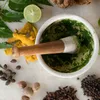Could COVID-19 bring a shift in the alternative medicine industry?
The COVID-19 pandemic has led to a surge in demand for alternative medicine. Here’s what the industry can expect in the near future.

Amidst this global pandemic, the fundamental priority of individuals and societies should be to stay safe and healthy.
Not only has this led to a spike in demand for cleaning products such as sanitisers and disinfectants, which protect against contracting COVID-19 from external sources, but also a rise in demand for immunity boosting supplements and medicine, which serve to strengthen the immune system from within.
An industry that has benefitted from this surge in demand is that of alternative medicine, contributed particularly by the growth of Traditional Chinese Medicine (TCM) and Ayurvedic Medicine.
In this report, we seek to cast light on the trends in the alternative medicine industry, particularly focussing on TCM and Ayurvedic Medicine.
We will examine alternative medicine companies making waves in these times, and explore what the future could possibly look like for this sector.
The Big Picture
Traditional and complementary medicine (T&CM) is an important, but often overlooked segment of healthcare. Found in almost every country, its demand by consumers, regulatory acceptance, and medical usage has been on the rise, and is likely to continue to grow in the coming years.
According to the World Health Organisation (WHO) Traditional Medicine Strategy 2014–2023, the promotion of universal health coverage by integrating TCM services into healthcare service delivery and self-health care is one of the WHO’s three strategic objectives.
Additionally, the number of WHO member states with a national policy on TCM has almost quadrupled, from 25 in 1999 to 98 in 2018. Despite some beliefs that alternative medicines are baseless and/or unscientific, it must be acknowledged that the use of TCM of proven quality, safety, and efficacy contributes to the goal of achieving universal health coverage, and can be complementary to (but likely not a replacement for) modern western medicine.
Having addressed the relevance and significance of alternative medicine in the bigger picture of promoting universal health coverage, two significant types of alternative medicine — TCM and Ayurvedic Medicine — also represent thriving global markets.
China’s TCM production was worth $48 billion in 2017, while the global Ayurveda market was valued at $4.5 billion in the same year, with expectations of the latter growing to $14.9 billion by 2026. Their combined value of $52.5 billion represented a small yet significant share (5.61 percent) of the global pharmaceuticals market, which stood at $934.8 billion in 2017. With the TCM and Ayurveda markets representing large players in the global economy, they are definitely deserving of deeper exploration.
Let’s dive in.
Analysis of Alternative Medicine Industry Trends
Traditional Chinese Medicine (TCM)
In China, more than 90 percent of the patients were given Traditional Chinese Medicine (TCM) to fight COVID-19. These medicines were administered by hospitals under the instruction of the government. It was projected as a complementary solution to Western medicine for increasing immunity.
Looking backwards, based on data from the WHO, it is estimated that only 58.3 percent of all SARS patients in China received TCM intervention. The sheer increase in the number of patients receiving TCM for COVID-19 depicts favourable growth in the acceptance of alternative medicine as a means of treatment.
For instance, Lianhua Qingwen, a TCM drug produced in the aftermath of SARS, accounted for 66 percent of the Yiling Pharmaceutical Group’s Q1 revenue, up from 29 percent YoY.
It has also been recognised as part of China’s standard treatment for COVID-19, and its daily production volume soared to two million boxes (as of April 24). This acceptance of alternative medicine is not just limited to China and is expected to grow significantly in the future.

The reason for this growth can also be attributed to the push of TCM from China with regards to its ‘Belt and Road Initiative.’ China has set up a group of centres in relevant Belt and Road regions to build a base for international cooperation and exchanges of TCM.
During the pandemic, the use of this medicine may result in the further global adoption of alternative medicine and possibly its long-term acceptance as mainstream medicine. With the WHO removing its previous advisory of not taking traditional herbal remedies for COVID-19, the global demand has also grown.
Beijing Tong Ren Tang, a popular manufacturer of TCM medication, has issued preventive medicines for 35 countries, with over 70 different herbal prescriptions. They also donated 4,000 doses of TCM to Singapore and Toronto, and over 20,000 doses of cold granules to Seoul.
Further, after China’s emphasis on TCM helping with the COVID-19-fight, the European market saw a surge in demand.
In Europe, a granulated form of TCM has gained popularity, with 20,000 boxes delivered by a single supplier to be sold in 5 countries, with a follow-on plan of importing 15,000 boxes a week.
Ayurveda
According to the President of the Ayurveda Medical Association of India, the ingredients of TCM and Ayurveda are similar, and thus have similar functionalities. The Ayurveda market in India, as mentioned above, was estimated to be at Rs 300 billion ($4.5 billion) in 2017, and is continuously growing.
We can see Ayurveda being integrated into the Indian economy through examples like the Association being in talks with the government of Goa to adopt Ayurveda as a preventive measure for the recent pandemic.
The governments of Kerala and Tamil Nadu have, in the past, administered alternative medicines for diseases like chikungunya and dengue, thus showing promise of the effectiveness of Ayurveda in helping national immunity.
Prime Minister Narendra Modi recently launched the ‘Drug Discover Hackathon’ as an endeavour for doctors and scientists to design and test solutions for COVID-19. In response, a team of doctors, including recipients of national honours such as the Padma Shri and the Padma Bhushan, have created an Ayurvedic drug that will be undergoing clinical trials with the hopes of aiding COVID-19 patients.
Other Ayurveda market leaders like Patanjali are also making strides in their clinical trials to find a cure for the virus.
Due to the absence of allopathic treatment for COVID-19, Indians are turning towards alternative medicine. With the anxiety around the disease, people are seeking “back to roots” or “traditional” remedies, such as immunity boosters to seek comfort.
Examples include Auric, a company that makes Ayurvedic health drinks, which saw a 30–35 percent increase in the demand for its immunity-boosting drink.
Himalaya also reported a three-fold increase in sales for its immunity tablets, while Patanjali has planned to hire over 500,000 new employees in order to meet the increasing demand for their Ayurvedic products. Likewise, Dabur reported a 400 percent increase in the demand for its flagship product, Dabur Chyawanprash, an immunity and health booster.
Even after the pandemic, a demand for Ayurvedic products is projected. The reason being this being Indian millennials, who are increasingly shifting towards a culture of “Indianness”. Having grown up seeing Indian traditions like Yoga and drinks like chai get rebranded in the West and regain popularity, millennials are now getting drawn towards other historical practices that define India.
For instance, there has been a demand for products such as okra and lotus seed chips, with a focus on health. These snacks have traditionally been a part of the Indian palette and are seeing significant demand among millennials.
Similarly, Ayurveda will be in demand. This can already be seen with millennials taking “shots” of haldi (turmeric) or Ayurvedic anti-hangover capsules after a night out.

Looking Forward
Having seen the increased acceptance and adoption of Ayurveda in India, and TCM on a slightly more international scale, does the traction stop here?
We now go over what we think the future of alternative medicine as a whole could be like.
Shift Towards Holistic Wellness
There will be a shift in demand from a product-based approach to a holistic wellness approach, where companies will sell alternative medicines as a part of a larger wellness experience. This experience will incorporate various facets, such as fitness, meditation, and healthy eating, in combination with the practice of alternative medicine.
With a projected CAGR of four percent, the industry is being driven by the rise in health-conscious consumers, the growing prevalence of chronic lifestyle diseases, and wellness tourism.
Due to COVID-19, consumers will become more health conscious, shifting from a reactive approach in the immediate face of danger, to proactively taking good care of themselves. Post the pandemic, companies that focus on the holistic wellness of consumers will, therefore, be in demand.
Increased Acceptance Globally
According to CB Insights, longevity, health, and wellness will rise as an extravagant, cross-industry $8 trillion+ mega-market. Alternative medicines stand to play a role in this mega-market, not as a replacement of conventional pharmaceuticals, but as complementary to them.
Proper regulation and enforcement in the alternative medicine industry will help to build trust and confidence among users that only safe, effective, and high-quality medicines are made available to the public. This should also help combat some of the legitimacy concerns exhibited by many.
The number of WHO member states with regulations on herbal medicines has almost doubled, from 65 in 1999 to 124 in 2018, and the number of member states with a market surveillance system for the safety of herbal medicines also rose from 59 in 2005 to 84 in 2012.
Moreover, as many individuals have consumed alternative medicines as a means of treatment or prevention of COVID-19, they are more likely to be open to consuming alternative medicines for other ailments in the future, assuming, of course, that such medicines were effective in serving their purpose.
Anecdotal evidence from personal experiences of trusted friends and family members will also serve to accelerate the spread of alternative medicines across the world.
Backed by the advancement of domestic regulations and the WHO, as well as the upwards trend of TCM and Ayurveda’s market sizes, it can be reasonably inferred that as long as alternative medicines are certified to be safe through rigorous regulation and scientific validation, global acceptance is likely to increase over time.
Tech-Enabled Experiences
Alternative medicine has typically been associated with being used by the elder generations, with the younger generations generally more inclined towards Western medicine.
An Amity university study examined the usage and non-usage of Ayurveda, and found the slower action of implements and accessibility concerns were the most quoted factors behind why Ayurveda was overlooked.
Previously, healthcare norms were forced to innovate to match the tech-savviness and demands of millennials, who now comprise 30.05 percent of the global population. This innovation can be best exemplified by the rise of telehealth and eHealth services.
While Western medicine established a presence in the telehealth space, with players like , , and all offering these services, alternative medicine had kept to its roots.
However, in the age of artificial intelligence (AI) and machine learning (ML), even alternative medicine has started to modernise its offering, with players like and Huofar venturing into mobile applications to offer Ayurvedic and TCM practices to a larger audience.
However, there still exists a lot of potential for technological integration in the presently product-based alternative medicine industry.
Not only is there scope for technology to aid with the shift from a product-based business to a holistic wellness experience as mentioned earlier, but tech also could lend a hand with tackling some of the factors behind the non-adoption of alternative medicine.
Tech players could automate certain parts of the process, or perhaps democratise the access to alternative medicine, via marketplaces, eHealth offerings, and logistics endeavours.
The skincare and beauty segment saw 72 percent of respondents across all ages place importance on purchasing clean and healthy products. The same study found millennials specifically care more about the source and quality of products by 15 and 10 percentage points respectively, as compared to their older counterparts.
Given the recent upshot in the demand for self-grooming products with natural and non-toxic implements, the right kind of marketing can lead to an explosion in this segment, given that TCM has a very strong background here, and that its ingredients are key supplements for these products.
Furthermore, other research has found millennials’ sentiments with regards to sustainable and natural products aren’t just confined to the beauty segment but govern their purchasing in general.
Hence, there exists a significant and hitherto untapped market for alternative medicine in the millennial generation. However, the message will have to be rebranded and remarketed to emphasise values millennials hold, in order to ensure success. It will also require a technological makeover, starting possibly with social media channels.
Presently, the tech-enabled alternative medicines market is a blue ocean; it is large, even fragmented, and without any ‘market leader’.
While startups have already started realising this potential via their app offerings of scans, recommendations, and marketplaces, immense possibilities exist for the one who is able to integrate the core product of alternative medicine with a rounded experience and a tech-centred platform.
Medical Tourism for Alternative Medicines
When the COVID-19 pandemic slows down and society returns to normalcy, many people will be exiting this stressful situation seeking relaxation and ways to improve both their physical and mental wellbeing.
As explored during our previous article on the TravelTech industry, we expect the travel industry to take 45 months to recover from the pandemic. Ergo, our predicted changes in travel patterns will not occur in the short-run.
This extensive length of time required for recovery can be attributed not only to the resuscitation of markets such as hospitality and aviation, but also the elimination of fear within consumers.
Popular types of vacation seen before the pandemic were yoga or meditation retreats, typically including other wellbeing practices such as TCM and/or Ayurveda. With a combination of the rise in the global acceptance of TCM and Ayurveda, and strives to improve mental health and overall wellbeing, we expect to see an increase in the customer base and demand for such vacations.
Already, some businesses in the wellness hospitality industry such as Minor Hotel’s are seeing an increase in open bookings for their Ayurveda and detox experiences, while Sangha Retreat by Octave Institute in China just launched a wellness and immunity program.
We predict that as this market segment starts expanding, one of two things will happen. Either larger travel and tourism companies will create subsidiary groups that focus solely on such wellness trips, or startups specialising in this space will emerge after noticing the rise in demand.
The latter seems more likely, with larger firms later acquiring these startups and thus gaining an established wellness branch as part of the variety of trips they offer. With the rise of these trips, other associated businesses like hospitality will plan to incorporate wellness activities and spaces into their infrastructure.
Whether you believe alternative medicine is quackery or the quintessential medication for your healthcare needs, its relevance in the context of the current pandemic and the future growth of the industry is undeniable.
Moving forward, while the medicines themselves will remain the core of the alternative medicine industry, technology will play an increasing role at augmenting the delivery and acceptance of alternative medicine through telehealth, medical tourism, and social media, among others.
With COVID-19 spurring the consumption and proliferation of alternative medicines, potential for significant value capture in the industry exists for tech players who are able to augment the industry in ways such as providing holistic wellness, promoting acceptance of alternative medicines, creating tech-enabled experiences, and pioneering new medical tourism experiences in the market. Yet, these are but a few ways the future of alternative medicine could look like.
Whether you believe in alternative medicines or not, as the industry begins to shift, now is the time to sit up and take notice.
Edited by Saheli Sen Gupta
(Disclaimer: The views and opinions expressed in this article are those of the author and do not necessarily reflect the views of YourStory.)











